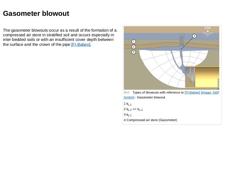
|

The gasometer blowouts occur as a result of the formation of a compressed air store in stratified soil and occurs especially in inter bedded soils or with an insufficient cover depth between the surface and the crown of the pipe [FI-Baben]. (Image: Types of blowouts - Gasometer blowout) |
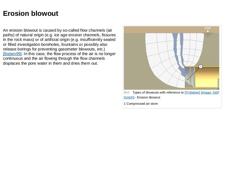
|

An erosion blowout is caused by so-called flow channels (air paths) of natural origin (e.g. ice age erosion channels, fissures in the rock mass) or of artificial origin (e.g. insufficiently sealed or filled investigation boreholes, fountains or possibly also release borings for preventing gasometer blowouts, etc.) [Baben99]. In this case, the flow process of the air is no longer continuous and the air flowing through the flow channels displaces the … |
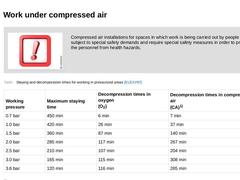
|

|
(Image: Attention!)
Compressed air installations for spaces in which work is being carried out by people are subject to special safety demands and require special safety measures in order to protect the personnel from health hazards. |
|
|
|
(Table: Staying and decompression times for working in pressurized areas) |
|
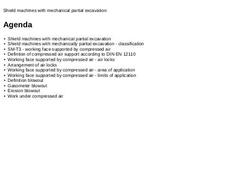
|

|
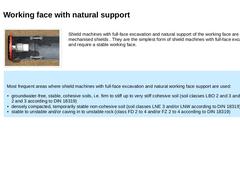
|

|
(Image: Shield machine with full-face excavation - working face with natural support (SM-V1)) |
Shield machines with full-face excavation and natural support of the working face are open, fully mechanised shields . They are the simplest form of shield machines with full-face excavation and require a stable working face. |
Most frequent areas where shield machines with full-face excavation and natural working face support are used: |
|
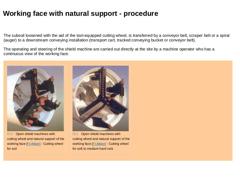
|

The subsoil loosened with the aid of the tool-equipped cutting wheel, is transferred by a conveyor belt, scraper belt or a spiral (auger) to a downstream conveying installation (transport cart, tracked conveying bucket or conveyor belt). The operating and steering of the shield machine are carried out directly at the site by a machine operator who has a continuous view of the working face. |
|
(Image: Open shield machines with cutting wheel and natural … |
|
|

|

|
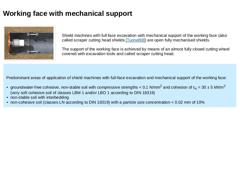
|

|
(Image: Shield machine with full-face excavation - working face with mechanical support (SM-V2)) |
Shield machines with full-face excavation with mechanical support of the working face (also called scraper cutting head shields [Tunnel98]) are open fully mechanised shields. The support of the working face is achieved by means of an almost fully closed cutting wheel covered with excavation tools and called scraper cutting head. |
Predominant areas of … |
|
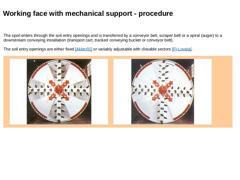
|

The spoil enters through the soil entry openings and is transferred by a conveyor belt, scraper belt or a spiral (auger) to a downstream conveying installation (transport cart, tracked conveying bucket or conveyor belt). The soil entry openings are either fixed [Akker01] or variably adjustable with closable sectors [FI-Lovata]. |
|
(Image: Open shield machine with scraper cutting head and mechanical support of the working face - Variably adjustable … |
|
|
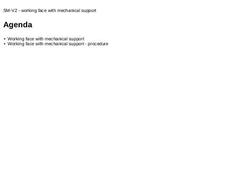
|

|
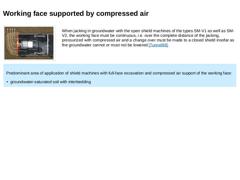
|

|
(Image: Shield machine with full-face excavation - working face with compressed air support (SM-V3)) |
When jacking in groundwater with the open shield machines of the types SM-V1 as well as SM-V2, the working face must be continuous, i.e. over the complete distance of the jacking, pressurized with compressed air and a change over must be made to a closed shield insofar as the groundwater cannot or must not be lowered [Tunnel98]. |
|
Predominant area … |
|
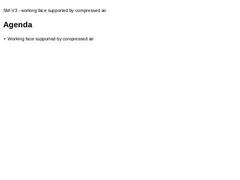
|

|
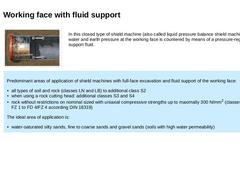
|

| (Image: Shield machine with full-face excavation - working face with fluid support (SM-V4))
|
In this closed type of shield machine (also called liquid pressure balance shield machine), the water and earth pressure at the working face is countered by means of a pressure-regulated support fluid. | |
Predominant areas of application of shield machines with full-face excavation and fluid support of the working face: - all types of soil and rock (classes LN …
|
|
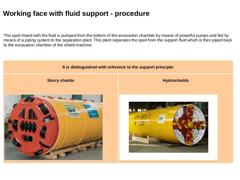
|

The spoil mixed with the fluid is pumped from the bottom of the excavation chamber by means of powerful pumps and fed by means of a piping system to the separation plant. This plant separates the spoil from the support fluid which is then piped back to the excavation chamber of the shield machine. |
|
It is distinguished with reference to the support principle: |
|
Slurry shields (Image: Slurry shield with rock cutting head of type AVN 1500 T (external … |
|
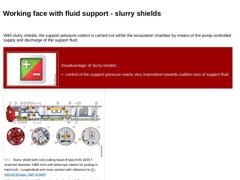
|

With slurry shields, the support pressure control is carried out within the excavation chamber by means of the pump-controlled supply and discharge of the support fluid. |
|
(Image: Pros and cons) |
Disadvantage of slurry shields: -
control of the support pressure reacts very insensitive towards sudden loss of support fluid
|
|
|
(Image: Slurry shield with rock cutting head of type AVN 1500 T (external diameter 1980 mm) with telescope station for jacking … |
|
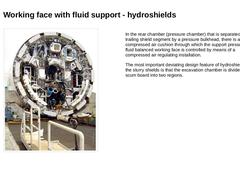
|

|
(Image: Hydroshield without boring head) |
In the rear chamber (pressure chamber) that is separated from the trailing shield segment by a pressure bulkhead, there is a compressed air cushion through which the support pressure at the fluid balanced working face is controlled by means of a compressed air regulating installation. The most important deviating design feature of hydroshields from the slurry shields is that the excavation chamber is divided … |
|
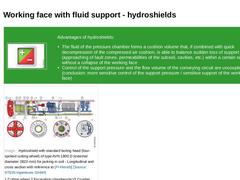
|

|
(Image: Pros and cons) |
Advantages of hydroshields: -
The fluid of the pressure chamber forms a cushion volume that, if combined with quick decompression of the compressed air cushion, is able to balance sudden loss of support fluid (approaching of fault zones, permeabilities of the subsoil, cavities, etc.) within a certain scope without a collapse of the working face
-
Control of the support pressure and the flow volume of the conveying circuit are …
|
|
|
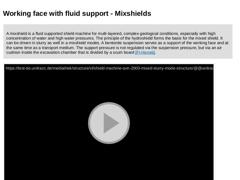
|

|
A mixshield is a fluid supported shield machine for multi-layered, complex geological conditions, especially with high concentration of water and high water pressures. The principle of the hydroshield forms the basis for the mixed shield. It can be driven in slurry as well in a mixshield modes. A bentonite suspension serves as a support of the working face and at the same time as a transport medium. The support pressure is not regulated via the … |
|
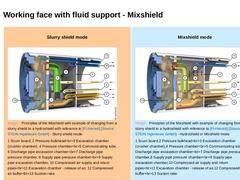
|

Slurry shield mode (Image: Principles of the Mixshield with example of changing from a slurry shield to a hydroshield with reference to [FI-Herreb] [Image: S&P GmbH] - Slurry shield mode)
| Mixshield mode (Image: Principles of the Mixshield with example of changing from a slurry shield to a hydroshield with reference to [FI-Herreb] [Image: S&P GmbH] - Hydroshield or Mixshield mode)
|
|
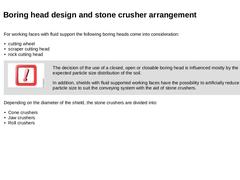
|

|
For working faces with fluid support the following boring heads come into consideration: -
cutting wheel
-
scraper cutting head
-
rock cutting head
|
|
(Image: Attention!)
The decision of the use of a closed, open or closable boring head is influenced mostly by the expected particle size distribution of the soil. In addition, shields with fluid supported working faces have the possibility to artificially reduce the particle size to suit the conveying system … |
|
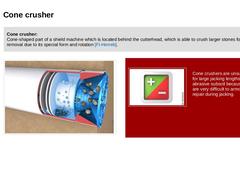
|

| Cone crusher:
Cone-shaped part of a shield machine which is located behind the cutterhead, which is able to crush larger stones for removal due to its special form and rotation [FI-Herreb]. | | | | (Image: Converting versions of the EPB UNCLEMOLE - Sketch of the principle of the slurry shield mode with reference to [FI-Isekib] [Image: S&P GmbH]) | (Image: Pros and cons) Cone crushers are unsuitable for large jacking lengths and in abrasive subsoil because … |
|
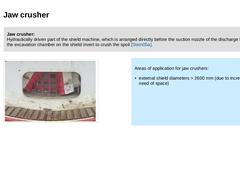
|

|
Jaw crusher:
Hydraulically driven part of the shield machine, which is arranged directly before the suction nozzle of the discharge line in the excavation chamber on the shield invert to crush the spoil [Stein05a]. |
|
|
|
(Image: Jaw crusher with rake arranged on the shield invert) |
Areas of application for jaw crushers: -
external shield diameters > 2600 mm (due to increased need of space)
|
|
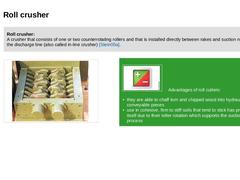
|

|
Roll crusher:
A crusher that consists of one or two counterrotating rollers and that is installed directly between rakes and suction nozzle of the discharge line (also called in-line crusher) [Stein05a]. |
|
|
|
(Image: Dismantled roll crusher (MOCO system [FI-Moco]) of a hydroshield with a shield diameter of 1966 mm [FI-Dywida]) |
(Image: Pros and cons)
Advantages of roll cutters: -
they are able to chaff torn and chipped wood into hydraulically conveyable …
|
|
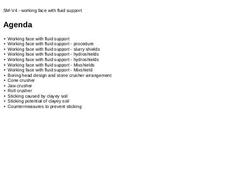
|

|
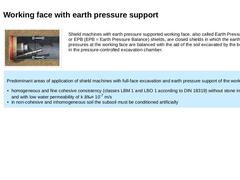
|

| (Image: Shield machine with full-face excavation - working face with earth pressure support (SM-V5))
|
Shield machines with earth pressure supported working face, also called Earth Pressure Shields or EPB (EPB = Earth Pressure Balance) shields, are closed shields in which the earth and water pressures at the working face are balanced with the aid of the soil excavated by the boring head in the pressure-controlled excavation chamber. | |
Predominant areas … |
|